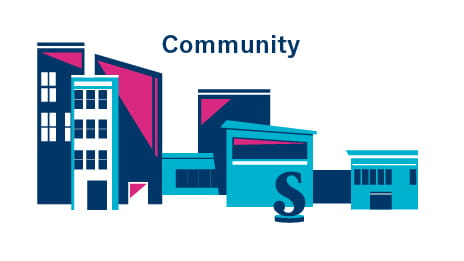Background
The Sheridan community cares deeply about health and wellness. We want our campuses to be supportive spaces that foster everyone’s mental, physical and social well-being -- opening up boundless opportunities for learning, engagement and innovation to flourish. That’s why Sheridan’s bold Strategic Plan makes wellness a top priority.
In 2019, Sheridan embarked on a process to develop a college-wide wellness strategy – one that will cultivate vibrant campuses across Sheridan grounded in the key principles outlined in the Okanagan Charter. We heard from over 3,000 voices in our community – students, employees, and external stakeholders – about what wellness should look like at Sheridan. Together with the best practices for well-being on campus laid out in the Charter, this feedback has been critical to the development of our community wellness strategy, titled, Sheridan Wellness: Our Strategy for Community Well-being.
The onset of the COVID-19 pandemic sharpened our focus on fostering wellness for both students and employees. As a result, Sheridan’s wellness strategy reflects not only feedback received during an extensive community consultation process but also the renewed focus on nurturing wellness in a challenging, rapidly changing environment.
The eight dimensions of wellness
Wellness is commonly viewed as having eight dimensions, each of which contribute to a personal sense of total well-being and quality of life, and each of which overlaps and affects the others.
Our community wellness strategy has been developed to reflect all eight dimensions of wellness: physical wellness; emotional wellness; intellectual wellness; social wellness; spiritual wellness; environmental wellness; occupational wellness and financial wellness.
Our Four Priority Areas
Sheridan’s wellness strategy is focused on developing key goals and objectives that align with the following four priorities. We will track our progress towards meeting our yearly objectives below.
Please note that these initiatives are subject to change based on the insights gained from our community, feedback from the Sheridan Wellness Committee and the success indicators developed as part of our strategy.-
Whole Systems Approach
We’ll align our framework for wellness at Sheridan with the best practices laid out in the Okanagan Charter – and formally commit to the Charter’s principles to embed wellness into all elements of campus culture, academics and operations.
KEY GOALS
- Create frameworks to embed wellness throughout our governance, policy and procedures, recognizing the impact they have on the physical, social and mental well-being of our community – bolstered by signing the Okanagan Charter.
- Form the Sheridan Wellness Committee and work closely with them to plan, implement and evaluate the success of our Wellness Strategy, ensuring that the voice of the Sheridan community remains at the heart of this work.
- Measure the success of our strategy by developing key wellness indicators for operations across the College and commit to continuous improvement as we implement our initiatives.
Year 1 completed objectives:
- Sign the Okanagan Charter - an International Charter for Health-Promoting Universities and Colleges, which calls upon postsecondary schools to embed health into all aspects of campus culture and to lead health promotion action and collaboration locally and globally. You can view Sheridan’s Statement of Commitment here.
- Create a Wellness Committee with representatives from all employee groups and the student body, which will guide the implementation of the wellness strategy.
Year 1 objectives in progress:
- Develop key wellness indicators to measure the success of Sheridan Wellness: Our Strategy for Community Well-being.
- Invest in the rollout of additional healthy workplace practices i.e. fifty minute meetings, flexible workplace options and COVID-19 campus policies.
Planned objectives for years 2-4
- Adopt the National Standard of Canada for Mental Health and Well-Being for Post-Secondary Students.
- Design a framework to guide a “health in all policies” approach.
-
Healthy, supportive environments
Each of our campuses is distinctive in its built, natural and cultural environments – all of which impact our physical, mental and social well-being. Recognizing the intersection between wellness, equity and inclusion, our strategy will ensure our campuses evolve in a way that helps foster connection, inclusivity and belonging.
Key goals
- Enhance our spaces – physical, social and virtual – with the goal of increasing access, inclusion and a sense of belonging for all community members.
- Support the implementation of Sheridan’s Campus Master Plan, which was developed with these unique qualities in mind and will guide current and future developments through a wellness lens.
- Champion events for both students and employees that reflect the different dimensions of wellness with a focus on fostering belonging and inclusion.
Year 1 completed objectives:
- Offer our students and employees a variety of activities to support belonging, inclusion and wellness. In 2020, these included: Mindful Mondays; the Sheridan Student Union’s Wellness Talks; Art Hives; Bruins’ Get Fit at Home workout series; Inclusive Communities webinar series; virtual cooking classes, virtual garden club; trivia and games nights.
Year 1 objectives in progress:
- Build partnerships with internal stakeholders such as Sheridan’s Facilities, Sustainability, Inclusive Communities and External Relations teams, as well as public health agencies, to support healthy environments.
- Adapt the Centre for Innovation in Campus Mental Health’s Wellness in Classrooms toolkit for Sheridan faculty members in partnership with the Centre for Teaching and Learning.
- Identify specific wellness principles for our physical campus spaces, which will guide future space planning.
Planned objectives for years 2-4
- Ensure that Sheridan’s external service agreements align with our wellness values and priorities.
-
Promoting lifelong wellness
We will build wellness competencies and knowledge among students, and employees, aided by a comprehensive communications strategy that engages, empowers and educates our community.
Key goals
- Continue developing resources and supports for students and employees in light of the ongoing pandemic.
- Support concrete opportunities for our community to learn more about health and wellness practices through comprehensive wellness programming, a robust online presence,and a wellness communications strategy.
- Contribute to the wider body of knowledge and practice of health and well-being.
Year 1 completed objectives:
- Provide a myriad of well-being resources for students and staff that respond to the challenges of the pandemic. In 2020, these included the Mental Health Library Guide,and the Start Well, Learn Well and Teach Well programs, designed to support students and faculty in learning and teaching in a remote environment.
Year 1 objectives in progress:
- Develop specific supports for students to help them manage the challenges of a remote work/study environment.
- Collaborate with the Sheridan 2024 Strategic Plan team to ensure the new signature Sheridan mindset for learning agility and resilience supports wellness and well-being.
- Make wellness resources easy to access through a robust wellness communications strategy, including an enhanced presence for wellness supports Sheridan Central and the Sheridan website.
Planned objectives for years 2-4:
- Create a community of practice for wellness researchers at Sheridan.
- Provide grants to students and/or staff for initiatives that support a healthy campus.
- Develop a champion recognition program highlighting students and employees who contribute to a healthy campus community.
-
Inclusive wellness services
We’ll continue to offer and expand on a spectrum of services to support the student/employee lifecycle and collaborate with our local communities to enhance access to external wellness services.
Key goals:
- Focus on developing services that support all eight dimensions of our students’ and employees’ wellness.
- Build and enhance partnerships with internal and external stakeholders that strengthen our community’s access to wellness services and resources including healthy food options, individualized supports such as counselling and connections to peers to foster belonging.
- Enhance targeted wellness supports and resources for equity-deserving groups.
Year 1 completed objectives:
- Provide our students and employees with additional wellness support options including better access to lower-intensity resources like self-guided web tools, peer supports and workshops.
- Decrease wait times for counselling services by creating an online booking system.
Year 1 objectives in progress:
- Include a wellness representative in Sheridan’s food services Request for Proposal process to inform future planning.
- Build partnerships with Halton and Peel Public Health units and local hospitals.
- Enhance the creation of targeted wellness supports and resources for equity-deserving groups.
Planned objectives for years 2-4
- Collaborate with Sheridan’s extended health providers to better promote the health benefits available to Sheridan students and employees.
Sheridan’s Wellness Committee
Formed in Fall 2020, the Sheridan Wellness Committee will be tasked with putting Sheridan Wellness: Our Strategy for Community Well-being into action beginning January 2021. This includes embedding wellness into our policies and procedures, physical and virtual campus spaces, learning opportunities and services, and bringing forward ideas on how to promote well-being through various campus initiatives, education, and partnerships with community organizations and resources. The Committee will work in collaboration with other Sheridan groups/departments to take a proactive, holistic approach to wellness that considers all aspects of our community’s well-being.
Committee members reflect the diversity of students and employees. The Sheridan Wellness Committee membership list can be found on Sheridan Central.
Any questions?
Contact us!
Please use the following form to reach the Wellness Strategy Team with any feedback or to ask any questions.









